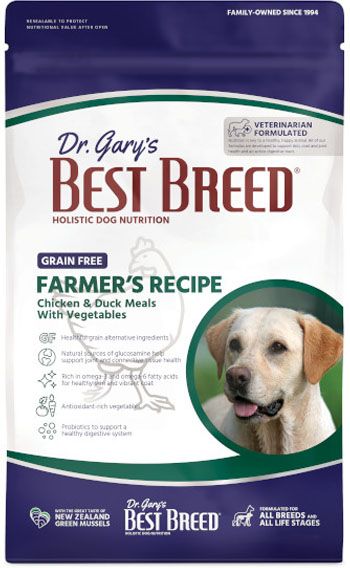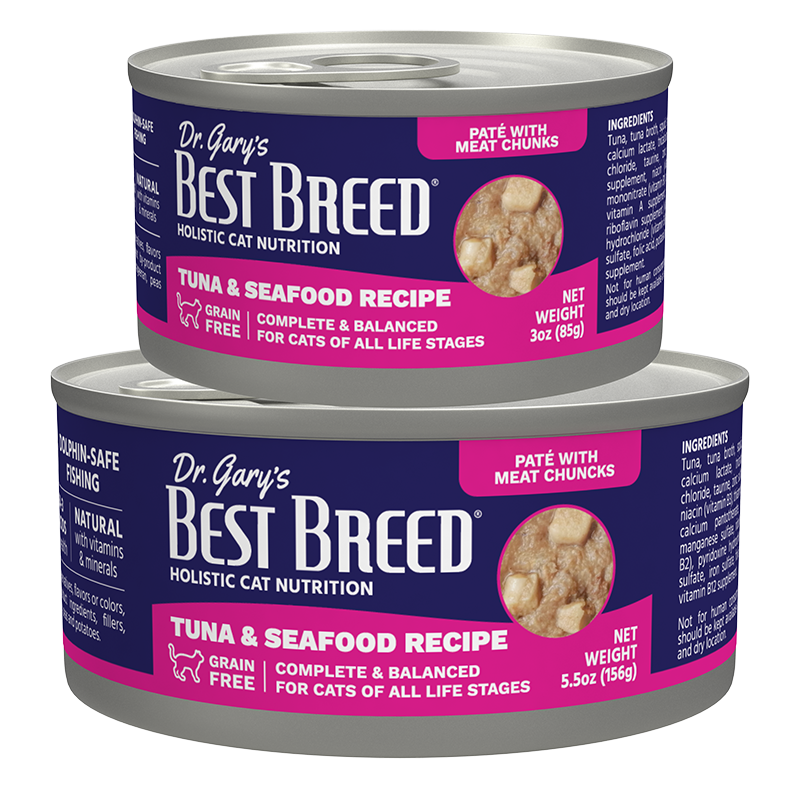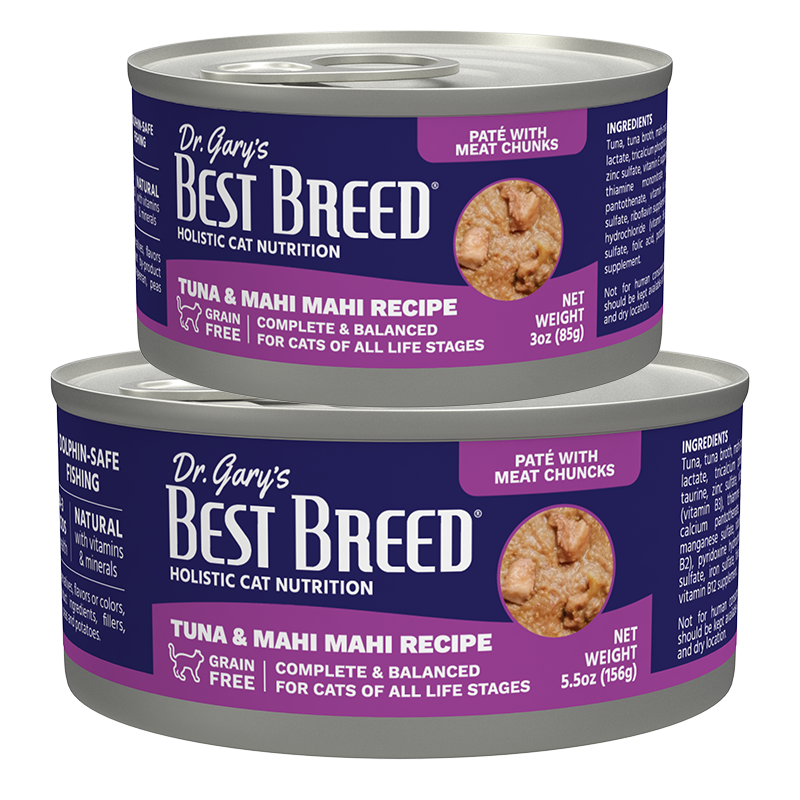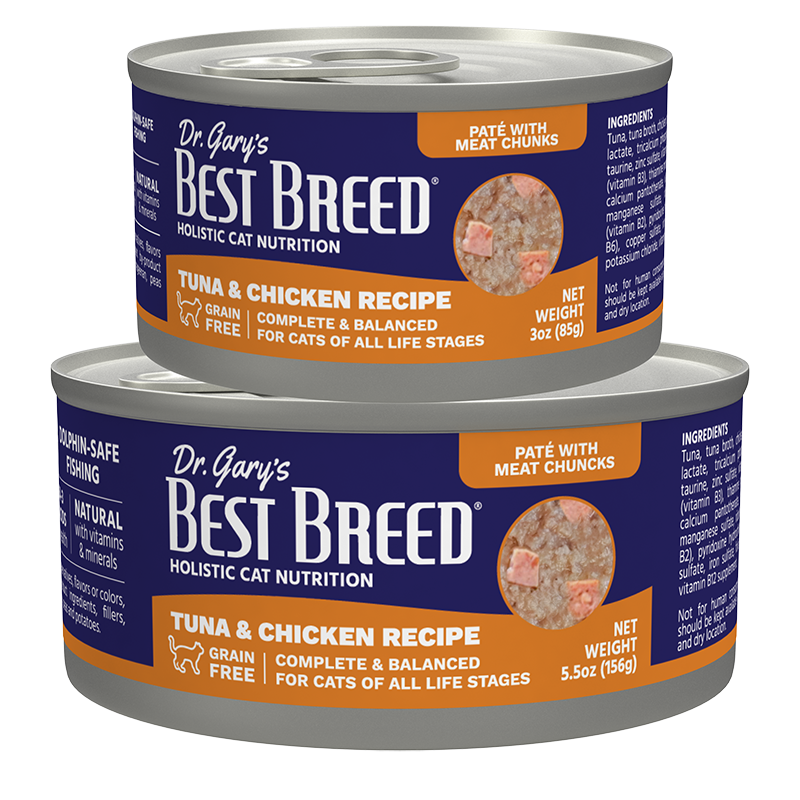Grain Free Farmer’s Recipe
Chicken & Duck Meals w/ Fruits & Veg.

Available in
4LB / 13LB / 26LB
A grain free blend of chicken, duck, fruits and vegetables. Excellent for dogs with sensitivities to grains.
- Made with taurine to support heart health.
- Rich in amino acids from high-quality chicken and duck to help maintain and build lean muscle mass.
- Gluten Free.
- Probiotics help benefit the immune system by promoting digestive health.
- Natural sources of glucosamine support proper joint and connective tissue health.
- Antioxidant-rich fruits and vegetables, including blueberries, cranberries, carrots, tomatoes and spinach, help maintain a strong immune system.
- The synergistic combination of omega-6 and omega-3 fatty acids, amino acids, and chelated minerals assists in maintaining healthy skin and promoting a vibrant coat. (Omega 6:3 are balanced for optimum performance.)
- To help ensure your dog’s nutritional safety, Best Breed pays a premium for EU-approved natural ingredients.
- Best Breed Grain Free Farmer’s Recipe is formulated to meet the nutritional levels established by the AAFCO (Association of American Feed Control Officials) Dog Food Nutrient Profiles for all life stages, including growth of large size dogs (70lbs. or more as an adult). This formula will benefit dogs of sizes and life stages (puppy through senior).
Watch the best breed story here.
Dear Dog Enthusiast,
Over the years one question we have received repeatedly from caring pet parents is, “why does Best Breed not have a grain free formula?” The simple answer has been that we have not felt comfortable with many of the non-grain ingredients used in grain-free pet food formulas. I have felt, and still feel, that healthy grains, when used as part of a complete and balanced formula, are much better for pets than grain free ingredients like potatoes.
After years of research and careful consideration, we have now developed grain free formulas with ingredients such as green peas, chick peas, ground flax seed and other fruits and vegetables, all of which are healthier and help promote sustainable energy.
Lastly, like all of our diets, the Grain Free Farmer’s recipe is formulated without low-grade ingredients that are harder for your dog to digest and may be harmful to his health. Some of these ingredients include animal by-product meal, cheap fillers, any sort of gluten (e.g., corn gluten), and artificial preservatives, flavors, and colors.
Sincerely,

Chicken Meal, Red Lentils, Chickpeas, Green Peas, Chicken Fat (Preserved with Mixed Tocopherols), Duck Meal, Tapioca, Whitefish Meal, Canola Oil (Preserved with Mixed Tocopherols), Dried Tomato Pomace, Natural Chicken Flavor, Ground Flaxseed, Menhaden Fish Oil (Preserved with Mixed Tocopherols), Lecithin, Dried Carrots, Dried Spinach, Dried Cranberries, Dried Blueberries, Dried Kelp, New Zealand Green Mussel, Salt, Choline Chloride, DL-Methionine, Monosodium Phosphate, Taurine, L-Lysine, L-Carnitine, Vitamin E Supplement, Ascorbic Acid, Biotin, Niacin Supplement, d-Calcium Pantothenate, Vitamin A Acetate, Riboflavin Supplement, Vitamin B12 Supplement, Thiamine Mononitrate, Pyridoxine Hydrochloride, Citric Acid, Vitamin D3 Supplement, Folic Acid, Potassium Chloride, Ferrous Sulfate, Zinc Sulfate, Zinc Proteinate, Iron Proteinate, Zinc Oxide, Copper Sulfate, Manganese Sulfate, Manganese Proteinate, Copper Proteinate, Manganous Oxide, Sodium Selenite, Calcium Iodate, Lactobacillus acidophilus Fermentation Product Dehydrated.
Guaranteed Analysis
| Crude Protein (Minimum) | 32.0% |
| Crude Fat (Minimum) | 17.0% |
| Crude Fiber (Maximum) | 4.0% |
| Moisture (Maximum) | 10.0% |
| Omega-6 Fatty Acids (Minimum) | 3.6% |
| Omega-3 Fatty Acids (Minimum) | 0.9% |
Nutrition Analysis
This data is composed of calculated values using ingredient nutritional analysis and actual lab analysis of our foods. It is not intended to represent absolute values and therefore not guaranteed as in the above table. The information should be used as a helpful guide when determining if a specific formula is suitable for a known dietary requirement. Should you need any additional information, please do not hesitate to contact us.
| Calcium | 1.5% |
| Phosphorus | 1.1% |
| Ash | 6.9% |
| Potassium | 0.85% |
| Sodium | 0.29% |
| Magnesium | 0.1% |
| Zinc | 192 mg/kg |
| Manganese | 58 mg/kg |
| Iron | 258 mg/kg |
It is important to remember that your dog’s nutritional needs are unique and will vary with his environment, age and activity level. We recommend feeding to condition, this means using the following guide as a starting point, monitoring his weight and adjusting amounts accordingly. Feeding at least twice a day is optimal. Make sure fresh, clean water is available always.
| Body Weight (lbs.)
|
Cups Per Day**
|
|---|---|
| Up to 10 | 1/4 to 3/4 |
| 11-23 | 3/4 to 1-1/4 |
| 24-36 | 1-1/4 to 1-3/4 |
| 37-49 | 1-3/4 to 2-1/4 |
| 50-62 | 2-1/4 to 3 |
| 63-75 | 3 to 3-1/2 |
| 76-89 | 3-1/2 to 4 |
| 90 or More | 4 Cups Plus 1/2 Cup For Every 10 lbs. over 90 |
** 1 cup equals approximately 114 grams of food.
Best Breed Grain Free Farmer’s Recipe is formulated to meet the nutritional levels established by the AAFCO (Association of American Feed Control Officials) Dog Food Nutrient Profiles for all life stages, including growth of large size dogs (70lbs. or more as an adult).
Puppies: May feed up to 33% more than suggested adult levels to maintain optimum body weight.
Pregnant Females: Minimal increase needed during first 6 weeks. Weeks 7 through 9 increase up to 25%.
Lactating Females: Immediately after whelping nutritional demand increases by 50% when compared to maintenance levels. During peak lactation increase feeding up to 300% of regular intake.
Contains 476 Kcal per cup ME (metabolizable energy) and 4.0 oz. of food per standard 8 oz. measuring cup.


